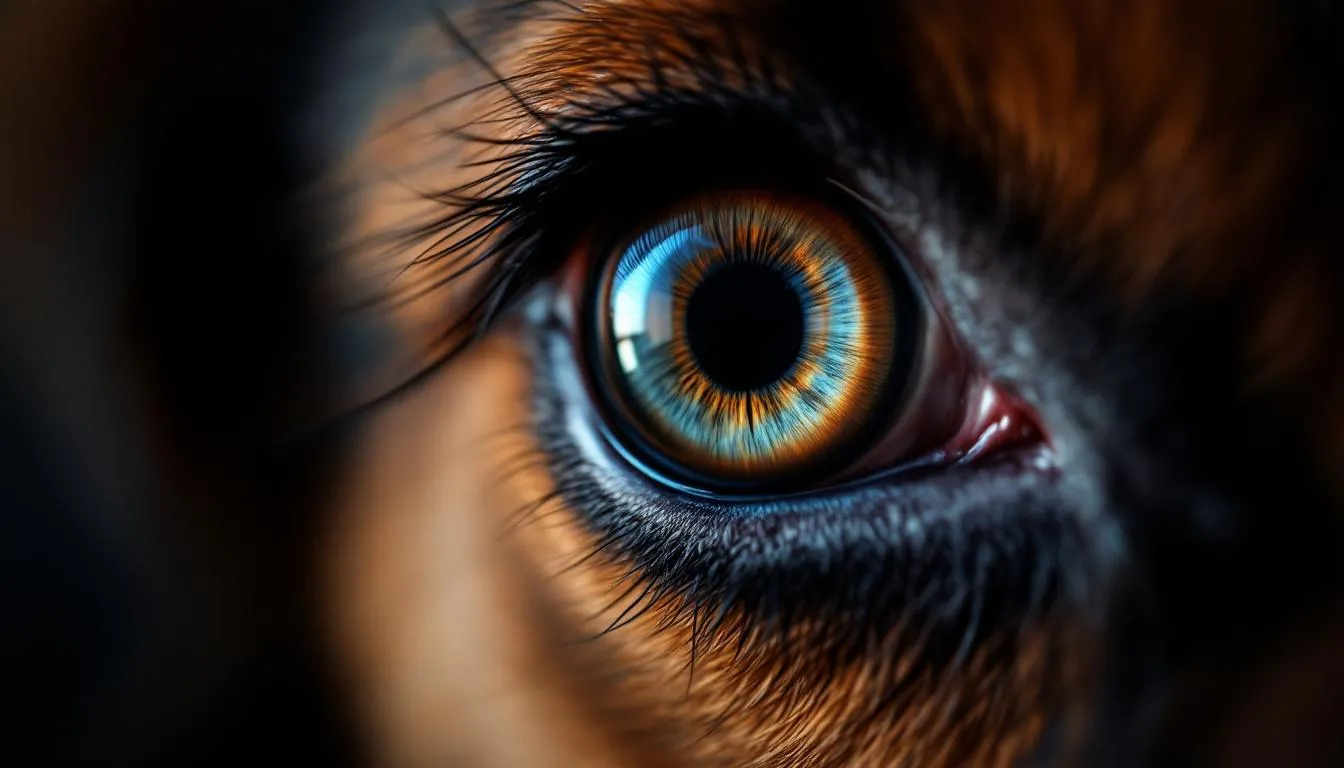

Key Takeaways
Progressive retinal atrophy (PRA) is an inherited genetic disease that causes gradual vision loss and eventual blindness in dogs
- Progressive retinal atrophy (PRA) is an inherited genetic disease that causes gradual vision loss and eventual blindness in dogs
- Night blindness is typically the first symptom, as rod cells responsible for low-light vision deteriorate before cone cells
- Most dogs completely lose their vision within 1-2 years after symptoms first appear, but adapt well to blindness
- There is currently no cure for PRA, but affected dogs can maintain excellent quality of life with proper management
- Genetic testing and breeding restrictions are essential for preventing PRA in future generations
Night blindness is typically the first symptom, as rod cells responsible for low-light vision deteriorate before cone cells
Most dogs completely lose their vision within 1-2 years after symptoms first appear, but adapt well to blindness
There is currently no cure for PRA, but affected dogs can maintain excellent quality of life with proper management
Genetic testing and breeding restrictions are essential for preventing PRA in future generations
When your dog begins hesitating at the top of stairs in dim light or seems reluctant to venture outside after sunset, these subtle behavioral changes might signal the early stages of progressive retinal atrophy. This inherited eye disease affects countless dogs worldwide, gradually stealing their vision while remaining completely painless throughout its progression.
Progressive retinal atrophy represents one of the most significant inherited conditions in veterinary medicine, particularly affecting purebred dogs across numerous breeds. Understanding this disease empowers owners to recognize early warning signs, seek appropriate veterinary care, and provide the best possible quality of life for their affected companions.
What is Progressive Retinal Atrophy?
Progressive retinal atrophy pra encompasses a group of inherited retinal diseases that systematically destroy the photoreceptor cells within a dog’s eyes. The retina, a thin tissue layer lining the back of the eyeball, contains specialized cells called rods and cones that convert light into electrical signals for the brain to interpret as vision.
Rod cells enable dogs to see in low light conditions and detect movement, while cone cells function in bright environments and allow for detail recognition. In progressive retinal atrophy, retinal degeneration begins with the deterioration of these crucial photoreceptor cells, leading to progressive vision loss that inevitably results in complete blindness.
This inherited disease affects both eyes equally, progressing at similar rates in each eye. The retinal blood vessels gradually become more visible as the surrounding tissue thins, and the normally dark areas of the retina begin reflecting more light back through the pupil. Unlike many other eye conditions, progressive retinal atrophy causes no pain or inflammation, making it particularly challenging for owners to detect in its earliest stages.
The disease progresses systematically, with affected dogs first losing their ability to navigate in dim lighting before eventually becoming completely blind. This bilateral nature ensures that no compensation occurs between eyes, though dogs rely heavily on their other senses to adapt remarkably well to their changing vision.


Types of Progressive Retinal Atrophy
Progressive retinal atrophy manifests in several distinct forms, each characterized by different onset timing and progression patterns. Understanding these variations helps owners and veterinarians anticipate disease development and plan appropriate management strategies.
Early onset PRA , also known as retinal dysplasia or photoreceptor dysplasia, affects puppies as young as 8-12 weeks old. In this form, photoreceptor cells fail to form properly during development, leading to rapid vision deterioration. Affected puppies may show signs of vision problems almost immediately, with complete blindness often occurring within months.
Late onset PRA typically emerges in adult dogs between 3-9 years of age, though some breeds may develop symptoms even later. This form involves the gradual deterioration of initially normal photoreceptor cells, with the disease progresses more slowly than early onset variants. Late onset form allows dogs to experience several years of normal vision before symptoms appear.
Progressive rod cone degeneration, commonly abbreviated as PRCD, represents one of the most widespread forms of late onset pra. This autosomal recessive condition affects multiple dog breeds and follows a predictable pattern where rod cells degenerate first, followed by cone cells. The progressive rod cone degeneration pattern explains why night blindness appears as the initial symptom.
Each type progresses at different rates, with early onset forms potentially causing complete vision loss within weeks to months, while late onset varieties may take 1-2 years from symptom onset to total blindness. The specific genetic mutation involved determines both the timing and speed of retinal degeneration.
Dog Breeds at Risk for PRA
Progressive retinal atrophy affects over 100 dog breeds, with certain breeds showing particularly high susceptibility due to their genetic heritage and breeding history. Labrador retriever populations carry several PRA variants, making genetic testing especially important for this popular breed.
High-risk breeds include Poodles of all sizes, Golden Retrievers, Cocker Spaniels, Irish Setters, and Australian Cattle Dogs. These commonly affected breeds often carry specific genetic mutations that have been identified and can be detected through DNA testing. Shetland Sheepdogs and Papillons also show notable predisposition to certain PRA variants.
Tibetan terriers deserve special mention as they’re susceptible to multiple forms of progressive retinal atrophy, including both early and late onset varieties. This breed’s genetic diversity includes several different PRA mutations, making comprehensive genetic testing particularly valuable for breeding programs.
Other breeds with documented PRA susceptibility include:
- English Springer Spaniels
- Portuguese Water Dogs
- Nova Scotia Duck Tolling Retrievers
- Miniature Schnauzers
- Akitas
- Mastiffs
English Springer Spaniels
Portuguese Water Dogs
Nova Scotia Duck Tolling Retrievers
Miniature Schnauzers
Akitas
Mastiffs
While purebred dogs face higher risks due to concentrated gene pools, mixed breed dogs can also develop progressive retinal atrophy if they inherit the necessary genetic combinations from their parent breeds. The autosomal recessive trait means that both parents must contribute a defective gene for most dogs to develop clinical disease.
Male dogs and female dogs are equally affected in most PRA forms, though X-linked variants exist in some breeds where inheritance patterns differ between sexes. Understanding breed-specific risks helps owners make informed decisions about genetic testing and breeding choices.


Clinical Signs and Symptoms
The earliest and most recognizable symptom of progressive retinal atrophy is night blindness, reflecting the initial loss of rod cell function that enables low light vision. Affected dogs may hesitate to enter dark rooms, show reluctance to go outside during evening hours, or appear disoriented when lighting conditions change suddenly.
As the disease progresses, owners often notice their dogs rely more heavily on familiar routines and environments. Dogs may bump into furniture that’s been moved or struggle to navigate stairs in dim lighting. These behavioral changes typically occur months before obvious physical signs become apparent to casual observation.
Physical clinical signs include dilated pupils that fail to constrict normally in bright light, increased reflectivity of the eyes when light shines into them, and gradual changes in the appearance of retinal blood vessels. A veterinary ophthalmologist can detect these changes during examination, even when the dog’s behavior hasn’t yet revealed vision problems.
Progressive symptoms include:
- Decreased vision in changing light conditions
- Bumping into objects, especially in unfamiliar environments
- Reluctance to jump or climb stairs
- Increased dependence on other senses like hearing and smell
- Eventually leading to complete daytime vision loss
Decreased vision in changing light conditions
Bumping into objects, especially in unfamiliar environments
Reluctance to jump or climb stairs
Increased dependence on other senses like hearing and smell
Eventually leading to complete daytime vision loss
Secondary cataracts may develop in the later stages of progressive retinal atrophy, appearing as cloudy areas within the lens. While these cataracts don’t cause the blindness (the retinal damage does), they can create additional visual obstacles and may require separate management.
Most dogs adapt remarkably well to their gradually decreasing vision, often maintaining normal activity levels and enthusiasm for life. Their enhanced reliance on other senses helps them navigate familiar environments with surprising competence, though they require additional support in new or hazardous situations.
Causes and Genetics
Progressive retinal atrophy results from inherited genetic mutations that disrupt normal photoreceptor cell function and survival. Most forms follow an autosomal recessive trait inheritance pattern, meaning affected dogs must inherit a defective gene from both parents to develop the disease.
In autosomal recessive inheritance, dogs with one normal and one defective gene become carriers without developing clinical signs themselves. When two carriers breed, approximately 25% of their offspring will be affected, 50% will be carriers, and 25% will be completely normal. This pattern explains why seemingly healthy parents can produce affected dogs.
Some breeds carry dominant gene variants where only one defective copy is needed to cause disease, while others have X-linked patterns affecting male dogs more frequently than females. The specific genetic variant determines not only the inheritance pattern but also the type of cells primarily affected and the progression timeline.
Rod cone dysplasia type variants specifically target different photoreceptor populations at various stages of development or maturity. Early onset forms often involve genes crucial for proper photoreceptor development, while late onset varieties typically affect genes responsible for maintaining cell function over time.
The photoreceptor degeneration process involves programmed cell death (apoptosis) triggered by the genetic defects. As these specialized cells die, they cannot be replaced, leading to permanently reduced retinal function. The retinal tissue gradually thins, and supporting structures like retinal blood vessels become more prominent.
Understanding the genetic basis has enabled the development of DNA testing for many PRA variants, allowing breeders to identify carriers and affected animals before symptoms appear. However, not all causative mutations have been discovered, and some breeds may carry multiple different variants requiring comprehensive testing approaches.


Diagnosis of PRA
Accurate diagnosis of progressive retinal atrophy requires comprehensive evaluation by a veterinary ophthalmologist or other qualified veterinary professional. The diagnostic process combines clinical examination, specialized testing, and often genetic analysis to confirm the condition and rule out other causes of vision loss.
A thorough eye examination reveals characteristic changes in the retina, including thinning of retinal tissue, increased visibility of retinal blood vessels, and enhanced reflectivity of the eye’s interior structures. These changes may be subtle in early stages, requiring specialized equipment and expertise to detect reliably.
Electroretinography (ERG) provides definitive confirmation of progressive retinal atrophy by measuring the electrical activity of photoreceptor cells. This test can detect retinal dysfunction even before visible changes occur in the eye’s appearance, making it valuable for early diagnosis and breeding decisions.
Genetic testing offers another diagnostic avenue for breeds with identified PRA mutations. DNA testing can confirm suspected cases and identify carrier animals before they show any symptoms. However, negative genetic tests don’t guarantee freedom from all PRA forms, as unknown mutations may exist in some breeds.
The diagnostic process also involves ruling out other conditions that can cause similar symptoms:
- Cataracts that block light transmission
- Glaucoma causing optic nerve damage
- Sudden acquired retinal degeneration (SARD)
- Retinal detachment from trauma or other causes
- Other inherited conditions affecting the optic nerve
Cataracts that block light transmission
Glaucoma causing optic nerve damage
Sudden acquired retinal degeneration (SARD)
Retinal detachment from trauma or other causes
Other inherited conditions affecting the optic nerve
Board certified veterinary ophthalmologist examination provides the most comprehensive assessment, combining multiple diagnostic approaches to reach accurate conclusions. Early diagnosis helps owners prepare for their dog’s changing needs and make informed breeding decisions if applicable.
Treatment and Management
Currently, no effective treatment exists to halt or reverse the progression of progressive retinal atrophy. The inherited nature of this retinal disease means that once photoreceptor degeneration begins, the process continues inexorably toward complete blindness. However, numerous management strategies can significantly improve quality of life for affected dogs.
Environmental modifications form the cornerstone of PRA management. Maintaining consistent furniture placement helps dogs navigate familiar spaces safely, while removing or padding sharp corners reduces injury risks. Installing baby gates at the top of stairs and maintaining clear pathways through living areas creates safer environments for dogs with decreased vision.
Adequate lighting in frequently used areas can help dogs with remaining vision function more effectively. Night lights in hallways and keeping food and water bowls in consistent locations reduce confusion and support independence. Some owners find that verbal cues and tactile markers help guide their dogs through daily routines.
Management strategies include:
- Keeping furniture arrangement consistent
- Using verbal commands to guide movement
- Providing textured mats to indicate important locations
- Ensuring adequate lighting in key areas
- Maintaining regular exercise routines with supervision
Keeping furniture arrangement consistent
Using verbal commands to guide movement
Providing textured mats to indicate important locations
Ensuring adequate lighting in key areas
Maintaining regular exercise routines with supervision
Secondary cataracts that occasionally develop may require separate attention, though cataract removal cannot restore vision lost to retinal degeneration. In some cases, cataract surgery might improve remaining vision if performed before complete retinal function is lost.
Experimental approaches including gene therapy show promise in research settings, though these treatments remain unavailable for routine clinical use. Some studies investigate antioxidant supplements and neuroprotective compounds, but no proven interventions currently exist to slow PRA progression.
The focus remains on helping affected dogs adapt to their changing vision while maintaining their physical health, mental stimulation, and emotional well-being. Most dogs adjust remarkably well to blindness, continuing to enjoy walks, play sessions, and social interactions with appropriate modifications.


Prognosis and Quality of Life
The prognosis for dogs with progressive retinal atrophy is ultimately complete blindness, typically occurring within 1-2 years after the first clinical signs appear. However, this seemingly dire prediction doesn’t reflect the reality of life for most affected dogs, who adapt remarkably well to their vision loss and maintain excellent quality of life.
Dogs naturally rely on multiple senses for navigation and environmental awareness, making them particularly well-suited to adapting to blindness. Their enhanced hearing, smell, and spatial memory help compensate for lost vision, allowing them to function normally in familiar environments.
The progression timeline varies significantly between breeds and individual dogs. Some early onset forms may cause complete vision loss within months, while certain late onset varieties progress more gradually over several years. Understanding the expected timeline helps owners prepare appropriate support systems.
Most dogs maintain their normal personalities, energy levels, and enthusiasm for activities throughout the progression of vision loss. They continue to enjoy walks (with leash guidance), play sessions, training activities, and social interactions with family members and other pets.
Quality of life considerations include:
- Maintained appetite and interest in food
- Continued enthusiasm for walks and exercise
- Normal sleep patterns and stress levels
- Positive interactions with family members
- Ability to navigate familiar environments safely
Maintained appetite and interest in food
Continued enthusiasm for walks and exercise
Normal sleep patterns and stress levels
Positive interactions with family members
Ability to navigate familiar environments safely
Life expectancy remains normal for dogs with progressive retinal atrophy, as the condition affects only vision without impacting other body systems. With proper management and environmental modifications, blind dogs often live full, happy lives that span their breed’s typical lifespan.
The key to maintaining quality of life lies in patient support during the adaptation period and consistent environmental management that promotes independence and confidence. Many owners report that their dogs’ personalities and relationships remain unchanged despite the vision loss.
Prevention and Breeding Considerations
Prevention of progressive retinal atrophy relies primarily on responsible breeding practices and genetic testing to identify affected dogs and carriers before they reproduce. DNA testing provides the most effective tool for reducing PRA prevalence in susceptible breeds.
Breeding programs should incorporate genetic testing for known PRA mutations, avoiding matings between two carriers that could produce affected puppies. However, completely eliminating carriers from breeding populations can reduce genetic diversity, so careful genetic counseling helps balance disease prevention with maintaining healthy gene pools.
DNA test limitations include the fact that not all PRA-causing mutations have been identified. Some breeds may carry unknown variants that current tests cannot detect, making it possible for “clear” dogs to still produce affected offspring in rare cases. Ongoing research continues to identify new mutations and develop additional testing options.
Recommended breeding practices include:
- Testing all breeding dogs for known PRA mutations
- Avoiding matings between two carriers when possible
- Maintaining detailed records of test results and ancestry
- Working with geneticists and veterinary ophthalmologists
- Participating in breed health surveys and research studies
Testing all breeding dogs for known PRA mutations
Avoiding matings between two carriers when possible
Maintaining detailed records of test results and ancestry
Working with geneticists and veterinary ophthalmologists
Participating in breed health surveys and research studies
Selective breeding based on genetic test results has successfully reduced PRA frequency in several breeds over the past decades. However, success requires widespread participation from breeders and ongoing vigilance as new mutations may be discovered.
For pet owners, genetic testing provides valuable information about their dog’s PRA status and potential risk for developing the condition. Early identification of affected dogs allows for better preparation and management planning, even before symptoms appear.
The collaboration between canine genetics researchers, veterinary professionals, and responsible breeders continues to drive progress in PRA prevention. As new mutations are discovered and testing options expand, the tools for preventing this inherited disease continue to improve.
FAQ
Can PRA be prevented through diet or supplements?
While antioxidant supplements may help delay cataract formation, there is no proven dietary prevention for PRA as it is a genetic condition. The disease results from inherited mutations that affect photoreceptor cell function, and no nutritional intervention can alter this genetic programming. However, maintaining overall eye health through proper nutrition may support general retinal function.
How quickly does PRA progress in different breeds?
Progression speed varies significantly by breed and PRA type, with most dogs losing complete vision within 1-2 years, though some breeds may progress faster or slower. Early onset forms can cause blindness within weeks to months, while late onset varieties typically progress over 1-3 years. Breeds like Irish Setters may show rapid progression, while others like Labrador Retrievers often have more gradual vision loss.
Can dogs with PRA still participate in activities and exercise?
Yes, dogs with PRA can continue to enjoy walks, play, and even some dog sports with proper supervision and environmental management. Many dogs adapt so well to blindness that they can participate in activities like agility training using verbal cues and familiar courses. Swimming, hiking on leash, and interactive puzzle games remain enjoyable activities for most affected dogs.
Is PRA painful for dogs?
No, PRA itself is not painful, though secondary complications like cataracts may occasionally cause discomfort requiring veterinary attention. The retinal degeneration process involves gradual cell death without inflammation or pressure changes that would cause pain. This painless nature can make early detection challenging, as dogs don’t exhibit discomfort behaviors that would alert owners to problems.
Should I get genetic testing for my dog even if they show no symptoms?
Yes, genetic testing is valuable for breeding decisions and early detection, especially in predisposed breeds, as it can identify carriers before symptoms appear. Testing helps breeders make informed mating decisions and allows owners to prepare for potential vision changes. Early identification also enables participation in research studies that may lead to future treatments.
FAQ
Can PRA be prevented through diet or supplements?
While antioxidant supplements may help delay cataract formation, there is no proven dietary prevention for PRA as it is a genetic condition. The disease results from inherited mutations that affect photoreceptor cell function, and no nutritional intervention can alter this genetic programming. However, maintaining overall eye health through proper nutrition may support general retinal function.
How quickly does PRA progress in different breeds?
Progression speed varies significantly by breed and PRA type, with most dogs losing complete vision within 1-2 years, though some breeds may progress faster or slower. Early onset forms can cause blindness within weeks to months, while late onset varieties typically progress over 1-3 years. Breeds like Irish Setters may show rapid progression, while others like Labrador Retrievers often have more gradual vision loss.
Can dogs with PRA still participate in activities and exercise?
Yes, dogs with PRA can continue to enjoy walks, play, and even some dog sports with proper supervision and environmental management. Many dogs adapt so well to blindness that they can participate in activities like agility training using verbal cues and familiar courses. Swimming, hiking on leash, and interactive puzzle games remain enjoyable activities for most affected dogs.
Is PRA painful for dogs?
No, PRA itself is not painful, though secondary complications like cataracts may occasionally cause discomfort requiring veterinary attention. The retinal degeneration process involves gradual cell death without inflammation or pressure changes that would cause pain. This painless nature can make early detection challenging, as dogs don’t exhibit discomfort behaviors that would alert owners to problems.
Should I get genetic testing for my dog even if they show no symptoms?
Yes, genetic testing is valuable for breeding decisions and early detection, especially in predisposed breeds, as it can identify carriers before symptoms appear. Testing helps breeders make informed mating decisions and allows owners to prepare for potential vision changes. Early identification also enables participation in research studies that may lead to future treatments.






